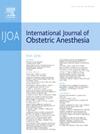用于硬膜外失阻检测的新型双手触觉模拟器:一项评估麻醉医生经验水平的运动策略和表现的试点研究。
IF 2.6
3区 医学
Q2 ANESTHESIOLOGY
引用次数: 0
摘要
背景:硬膜外腔的正确识别需要广泛的技术熟练训练。本研究探索了一种基于阻力损失(LOR)检测的新型双手触觉模拟器,用于硬膜外针的精确插入,提供真实的双手力反馈。方法:该模拟器配备两个触觉装置,连接到Tuohy针和LOR注射器,旨在模拟用户在手术过程中感受到的组织阻力,提供解剖变异性并记录详细的性能指标,以供个性化反馈。我们通过不同经验水平的麻醉师进行的尝试来评估模拟器的有效性,分析成功率、错误大小、患者体重的影响和运动策略。结果:不同麻醉医师的专业水平对麻醉效果有显著影响。专家们取得了较高的成功率和较小的错误,证明了模拟器的构造有效性。患者体重影响结果,体重高导致更多硬膜外穿刺失败,体重低导致意外硬膜穿刺增加。成功的尝试通常涉及更多的探查动作,特别是在硬膜外间隙附近。结论:创新的双手触觉模拟器显示了作为评估硬膜外技能和区分专业水平的工具的巨大潜力。它能够为双手提供真实的、同步的反馈,适应病人的解剖变化,并产生精确的性能评估指标,这使它与现有的模拟器区别开来。然而,需要进一步的研究来确定其作为一种培训工具的价值。计划中的研究将侧重于制定有效的培训方案,评估模拟器的长期教育影响,确定将其整合到住院医师项目中是否可以改善患者的治疗效果。本文章由计算机程序翻译,如有差异,请以英文原文为准。
Novel bimanual haptic simulator for epidural loss-of-resistance detection: a pilot study assessing movement strategies and performance across anesthesiologist experience levels
Background
Correct identification of the epidural space requires extensive training for technical proficiency. This study explores a novel bimanual haptic simulator designed for the precise insertion of an epidural needle based on loss-of-resistance (LOR) detection, providing realistic dual-hand force feedback.
Methods
The simulator, equipped with two haptic devices connected to a Tuohy needle and an LOR syringe, was designed to simulate the tissues’ resistive forces felt by the user during the procedure, offer anatomical variability and record detailed performance metrics for personalized feedback. We assessed the simulator’s validity through attempts conducted by anesthesiologists of varying experience levels, analyzing success rates, error sizes, the impact of patient weight, and movement strategies.
Results
Performance varied significantly with the expertise level of the anesthesiologists. Experts achieved higher success rates and smaller errors, demonstrating the simulator’s construct validity. Patient weight influenced outcomes, with higher weights leading to more failed epidurals and lower weights resulting in increased accidental dural punctures. Successful attempts typically involved more probing movements, particularly near the epidural space.
Conclusions
The innovative bimanual haptic simulator shows significant potential as a tool for assessing epidural skills and differentiating expertise levels. Its ability to provide realistic, concurrent feedback for both hands, adapt to patient anatomical variations, and generate precise metrics for performance evaluation distinguishes it from existing simulators. However, further research is necessary to establish its value as a training tool. Planned studies will focus on developing an effective training protocol and evaluating the long-term educational impact of the simulator, determining whether its integration into residency programs can improve patient outcomes.
求助全文
通过发布文献求助,成功后即可免费获取论文全文。
去求助
来源期刊
CiteScore
4.70
自引率
7.10%
发文量
285
审稿时长
58 days
期刊介绍:
The International Journal of Obstetric Anesthesia is the only journal publishing original articles devoted exclusively to obstetric anesthesia and bringing together all three of its principal components; anesthesia care for operative delivery and the perioperative period, pain relief in labour and care of the critically ill obstetric patient.
• Original research (both clinical and laboratory), short reports and case reports will be considered.
• The journal also publishes invited review articles and debates on topical and controversial subjects in the area of obstetric anesthesia.
• Articles on related topics such as perinatal physiology and pharmacology and all subjects of importance to obstetric anaesthetists/anesthesiologists are also welcome.
The journal is peer-reviewed by international experts. Scholarship is stressed to include the focus on discovery, application of knowledge across fields, and informing the medical community. Through the peer-review process, we hope to attest to the quality of scholarships and guide the Journal to extend and transform knowledge in this important and expanding area.

 求助内容:
求助内容: 应助结果提醒方式:
应助结果提醒方式:


